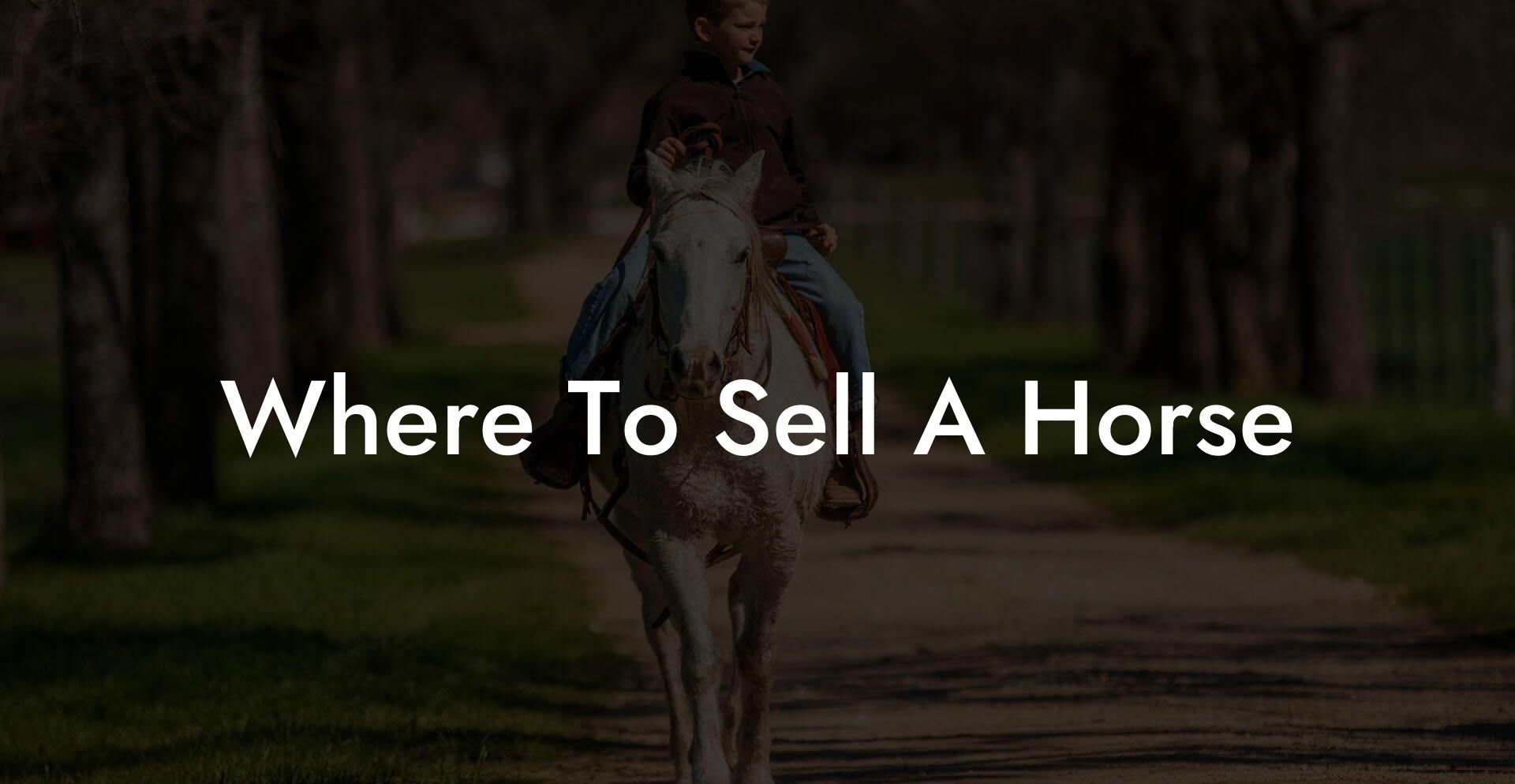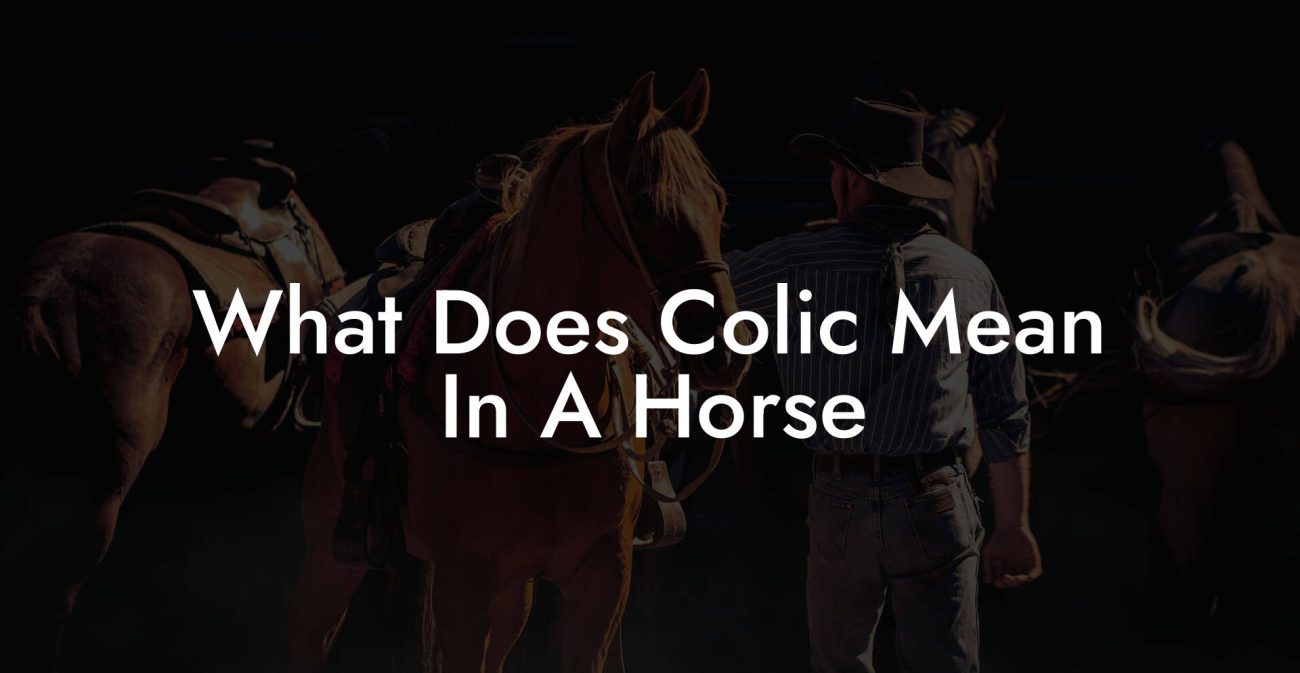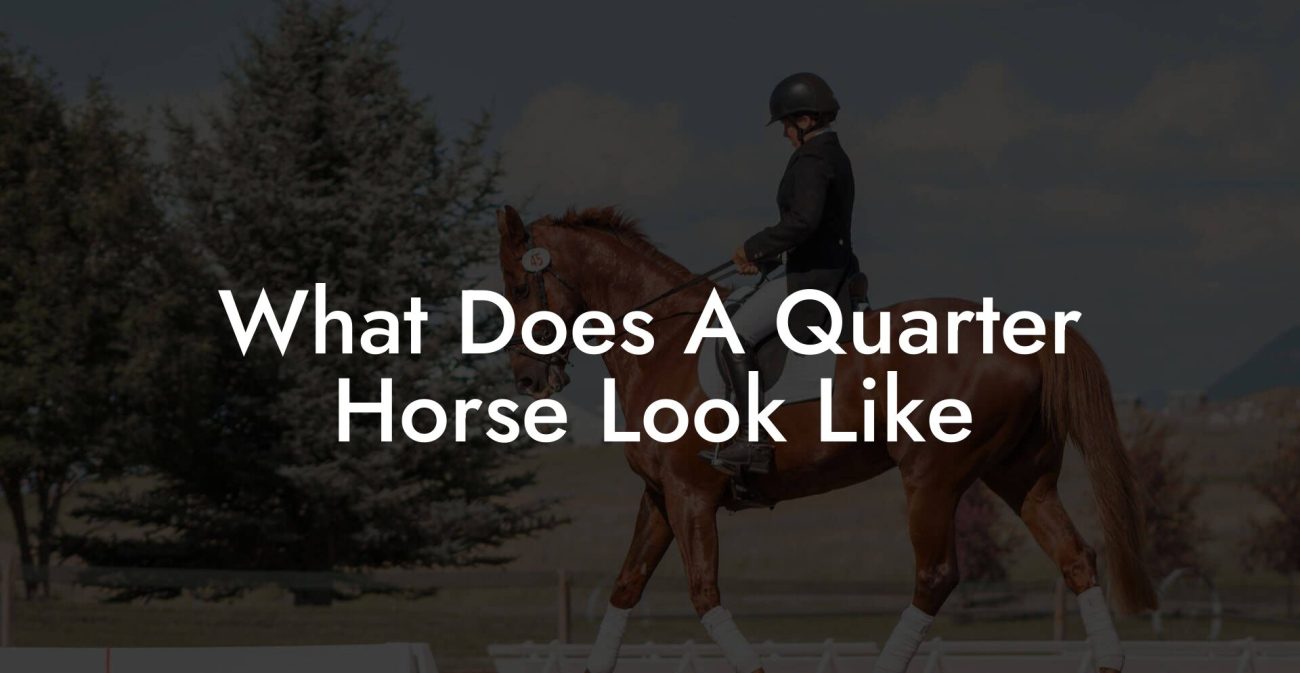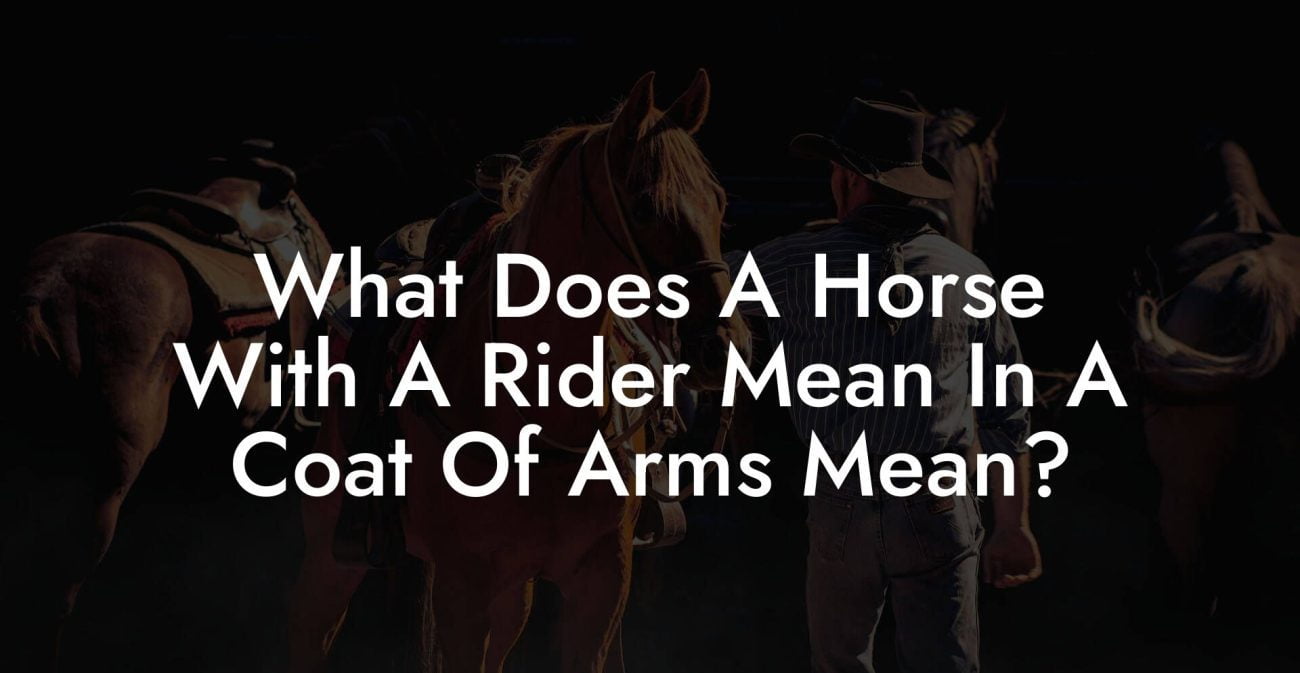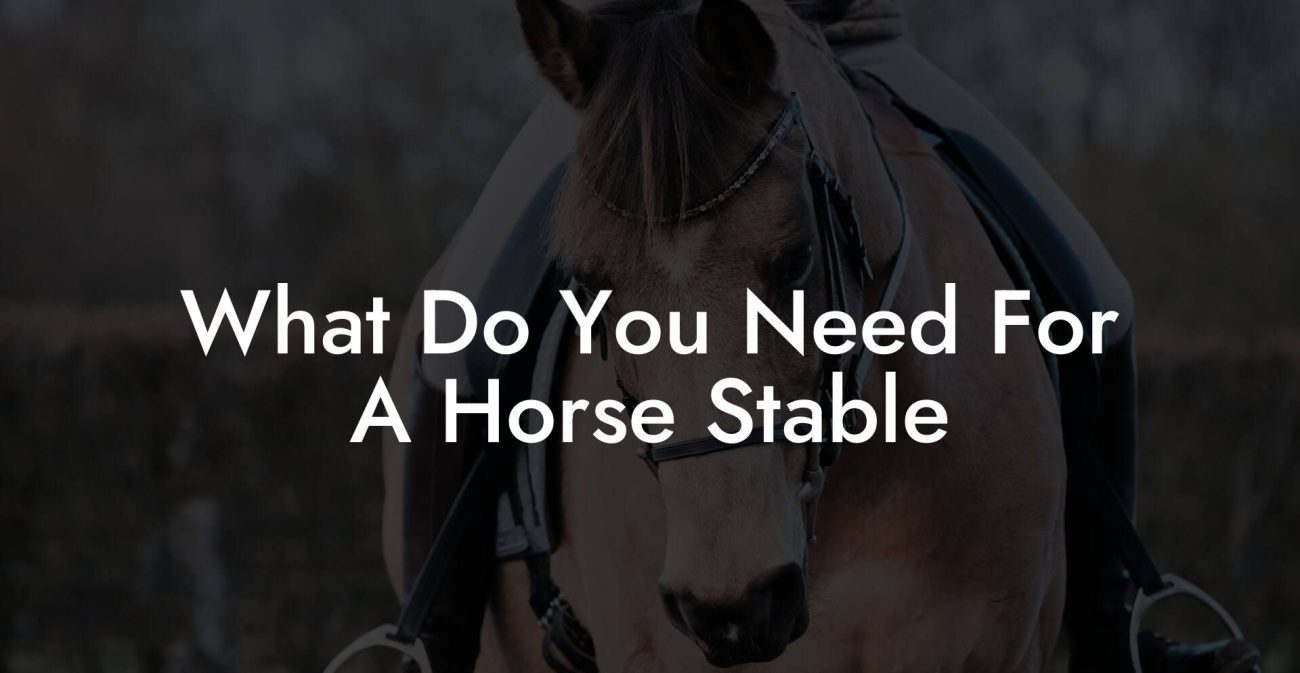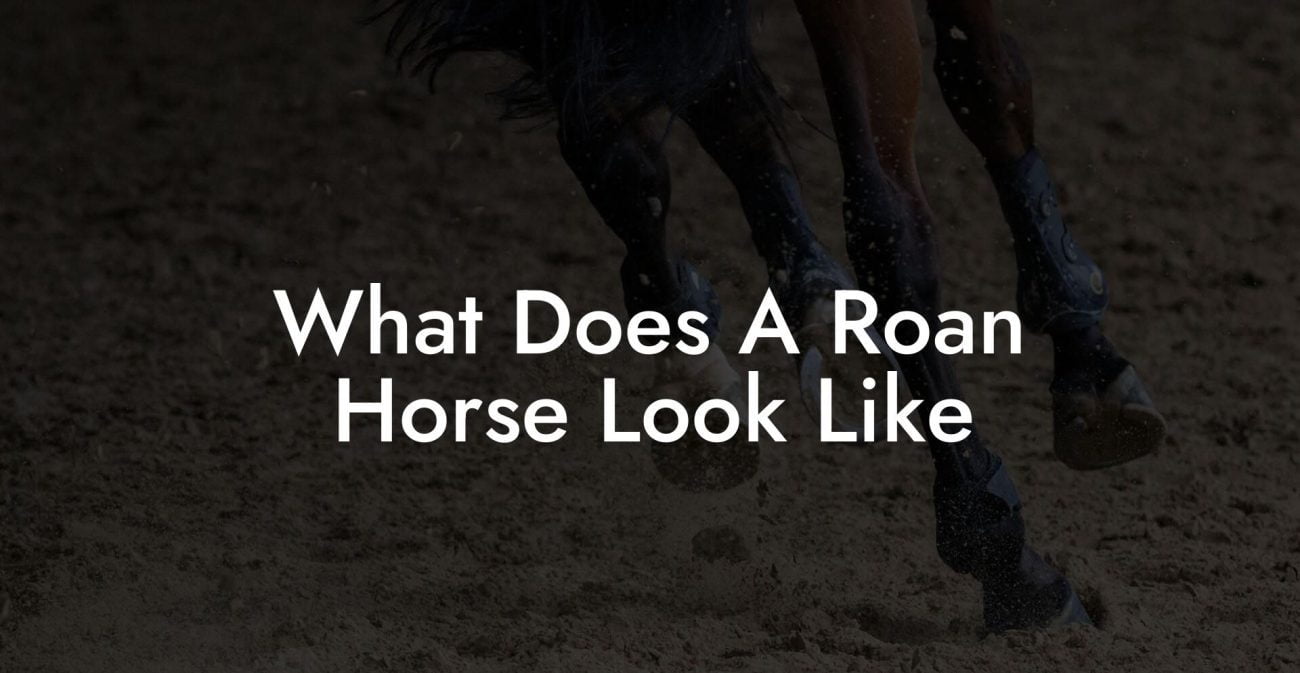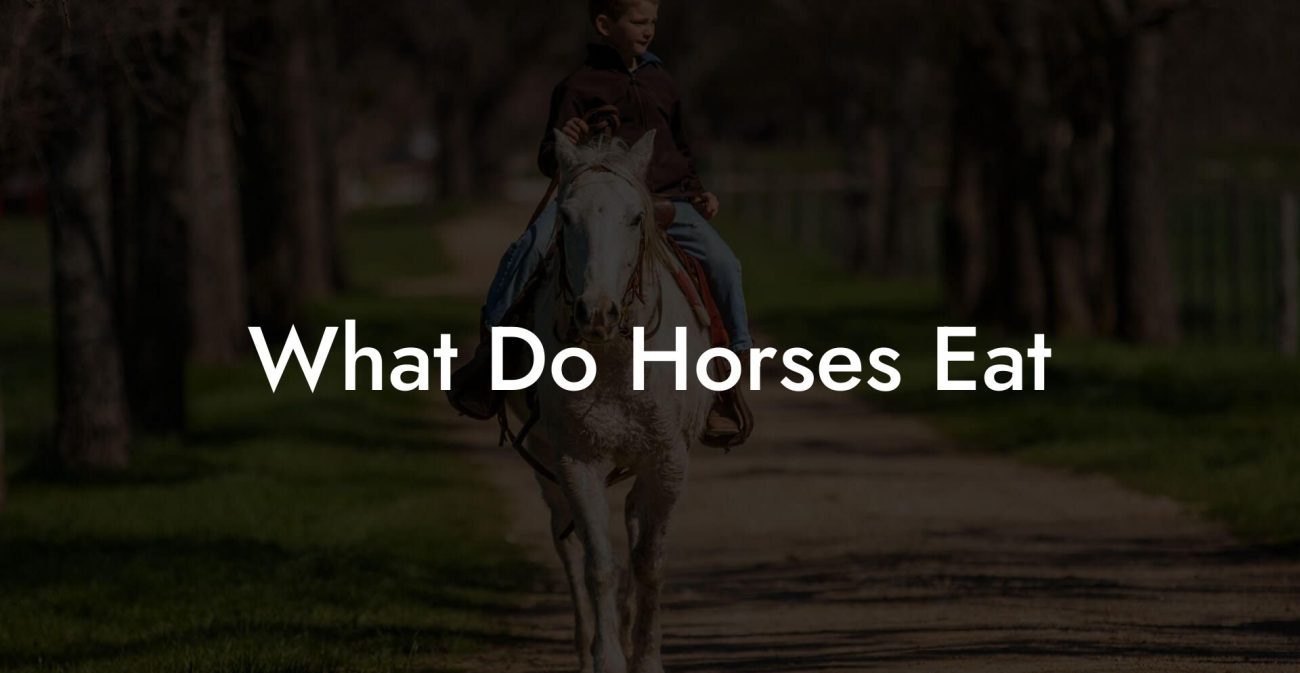Shifting from stable routines to saddle-up success, selling a horse isn’t just about finding a buyer, it’s about launching a full-on equestrian extravaganza that mixes savvy online tactics, old-school networks, and genuine passion for horse care. Whether you're upgrading your herd or saying goodbye to a long-time companion, knowing where to sell a horse may seem like deciphering a cryptic treasure map. But don’t worry, we’re here to break down the process with a blend of humor, real-talk advice, and practical tips that resonate with Gen Z and millennials alike.
Quick Links to Useful Sections
- The Modern Marketplace: Traditional Sale vs. Digital Platforms
- Navigating the Sales Process: Key Considerations for Your Equine Asset
- Assessing Your Horse’s Market Value
- Health Checks and Vet Certifications
- Grooming and Presentation: Your Horse’s Off-Sale Aesthetic
- Training, Temperament, and Performance History
- Digital Sales Strategies: Standing Out in the Online Equestrian Bazaar
- Creating a Compelling Listing
- Leveraging Social Media Channels
- Utilizing Dedicated Equine Marketplaces
- Offline Strategies: Tapping into Your Local Equine Community
- Local Auctions and Equestrian Events
- Word-of-Mouth Referrals
- Hosting Your Own Open House
- Caring for Your Horse During the Sales Process
- Maintaining Routine Health and Grooming
- Proper nutrition and Hydration
- Training and Behavioral Preparation
- Minimizing Stress During the Transition
- Marketing Your Horse Sale: Telling a Captivating Story
- The Power of a Narrative
- Highlighting Achievements and Special Talents
- Engaging Visual Content
- Legal and Financial Aspects: Dotting the I’s and Crossing the T’s
- Understanding Contracts and Agreements
- Transfer of Ownership and Registration
- Financial Arrangements and Payment Methods
- Building Relationships Post-Sale: Ensuring Happy Endings for Horses and Owners
- Providing a Smooth Transition
- Gathering and Sharing Feedback
- Staying Connected With the Community
- Resources and Community Support: Your Next Steps
- Pain Points and Success Stories: Real-Life Equine Sales Journeys
- Story 1: From Uncertainty to Online Triumph
- Story 2: Navigating Legal Labyrinths with Expert Guidance
- Story 3: Community Connections Making a Difference
- Advanced SEO Techniques to Optimize Your Horse Sale Listings
- Semantic Keyword Clustering
- Optimizing Visual Content
- Structured Data and Rich Snippets
- Content Freshness and Engagement Metrics
- FAQs About Selling Your Horse and Ensuring Top-Notch Horse Care
- Your Next Steps: Take Charge of Your Equine Sale Journey
The Modern Marketplace: Traditional Sale vs. Digital Platforms
When it comes to selling your horse, you’ve got options as diverse as the horses you might own! Gone are the days when selling meant pinning a flyer to the barn door; instead, the digital revolution has saddled up a whole new realm where websites, social media, and auction houses all converge to create a vibrant equestrian marketplace.
On one hand, there’s the trusted charm of traditional methods like in-person auctions, local classifieds, and word-of-mouth referrals. These approaches have been around since horses roamed the plains and often provide that face-to-face trust factor that some buyers still crave. On the other hand, selling your horse online opens up a world of opportunities with expansive reach, detailed listings, and even niche platforms that cater exclusively to equine enthusiasts.
We’re talking about platforms like EquineNow, DreamHorse, and even the mechanic of social media groups on Facebook or Instagram. With detailed profiles, high-quality photos, and videos showcasing your horse’s personality and prowess, online marketplaces give you a competitive edge. And let’s not forget, they offer the peace of mind that comes from ratings, reviews, and a community that values transparency.
Navigating the Sales Process: Key Considerations for Your Equine Asset
Before you contact potential buyers or list your horse online, there are several strategic steps you must tackle to ensure the smoothest possible sale. The process is not so different from preparing for a major performance: you need the right grooming, a confident stage presence, and a clear message about your horse’s capabilities.
Assessing Your Horse’s Market Value
Determining the selling price of your horse is an art in itself, one that balances market demand, the horse’s age, training level, health, pedigree, and even its personality. Online research, professional appraisals, and consultation with trusted trainers and veterinarians can help you pinpoint a fair asking price. Remember, a well-groomed, well-trained horse with a robust performance history can command a premium.
Health Checks and Vet Certifications
Nothing screams “trustworthy sale” like a clean bill of health. Ensure that your horse has up-to-date veterinary records, vaccinations, and a recent health check. Buyers often request these documents as assurances that they aren’t inheriting a horse with hidden issues. Investing in a pre-sale vet check not only builds buyer confidence but might also reveal any concerns that need addressing beforehand.
Grooming and Presentation: Your Horse’s Off-Sale Aesthetic
Ever noticed how influencers spend hours perfecting the aesthetics of their posts? Horses are no different. A well-groomed horse with shiny coats, clean tack, and a well-stacked conformation can make all the difference when a buyer is scrolling through listings. If your horse is camera-ready, it’s a reflection of the care they’ve received, and that speaks volumes to potential buyers.
Training, Temperament, and Performance History
Today’s buyers aren’t just looking for a pretty face; they want a partner in both work and play. Highlight any unique training, special skills, or performance accolades. Whether your horse is a champion in dressage, a star in show jumping, or a gentle trail buddy, make sure to spotlight those skills. Additionally, providing details about their temperament, such as being great with beginners or exceptional under pressure, can help tailor your sale to the right audience.
Digital Sales Strategies: Standing Out in the Online Equestrian Bazaar
The digital landscape offers a plethora of tools and strategies to amplify your horse sale. With an increasing number of Gen Z and millennial buyers turning to online platforms, understanding these strategies can ensure your listing doesn’t turn into just another pixel in the feed.
Creating a Compelling Listing
Think of your listing as a profile on a dating app, except instead of swiping right on a potential soulmate, buyers are evaluating the quality and compatibility of your horse. Invest in high-definition photos and dynamic videos that capture your horse in action. Write an engaging description that tells your horse’s story: mention their breed, training background, temperament, and any accolades, but do it with a conversational tone that feels genuine.
Spice up your listing with details that resonate with a modern audience, include fun facts, a quirky anecdote, or even an emoji or two that captures the essence of your equine friend. Keywords such as “Where to sell a horse,” “professional horse sale,” “equine marketplace,” and “buy quality horses online” should naturally seep into your content to boost SEO without sounding robotic.
Leveraging Social Media Channels
Social media is a powerhouse for reaching a broad, engaged audience. Platforms like Instagram, Facebook, TikTok, and even Reddit have vibrant communities that discuss everything from horse riding adventures to the finest details of horse care. Create engaging posts, reels, or stories that highlight your horse’s best moments, whether it’s a graceful trot through sun-kissed fields or a playful interaction with fellow equines. Incorporate hashtags, such as #HorseSales, #EquineLife, and #HorseCareTips, to reach niche audiences who are actively seeking quality horses.
Utilizing Dedicated Equine Marketplaces
Websites dedicated to horse sales like EquineNow, DreamHorse, and HorseTrader are hub spots designed just for buyers and sellers. These platforms attract an audience that is specifically looking to invest in equine talent, making them ideal for reaching serious buyers. Detailed profiles, advanced search filters, and community reviews on these sites ensure your horse gets the spotlight it deserves.
For those with a tech-savvy edge, consider integrating digital tools such as virtual tours or even a live-streamed Q&A session about your horse. These interactive elements create a deeper connection with potential buyers and show that you’re transparent and dedicated to horse care.
Offline Strategies: Tapping into Your Local Equine Community
Don’t underestimate the enduring value of offline strategies when it comes to selling a horse. Local events, word-of-mouth referrals, and community bulletins can be just as effective as digital tools, especially in tight-knit equine communities.
Local Auctions and Equestrian Events
Traditional horse auctions and local equestrian events are more than just bidding wars, they’re vibrant gatherings where enthusiasts share stories, trade tips, and celebrate the legacy of horsemanship. Participating in these events can build trust and foster relationships that may lead to a quicker sale. Make sure to network with fellow horse owners, trainers, and potential buyers who are on the lookout for reliable, well-cared-for horses.
Word-of-Mouth Referrals
Just as many trust the advice of a friend when choosing a new restaurant or binge-worthy TV series, potential buyers often lean on recommendations from peers in the equine world. Don’t be shy about tapping into your network. Share your plans on local message boards, community newsletters, or even at your regular stable visits. Building a rapport with other horse enthusiasts can create opportunities that might not surface online.
Hosting Your Own Open House
Consider hosting an open house at your ranch or stable. This low-key, invitation-only event allows prospects to interact with your horse in a relaxed setting. It also offers a unique chance to display your star’s training, discuss its history, and give firsthand tidbits about its personality. An open house not only builds trust but also transforms a simple sale into a memorable experience.
Caring for Your Horse During the Sales Process
Even as you gear up to sell, the welfare and happiness of your horse must remain a top priority. After all, a happy, healthy horse is your best advertisement. Balancing the sales process with proper horse care is essential, and here are a few key pointers to keep everything in check.
Maintaining Routine Health and Grooming
Consistency is king when it comes to horse care. Continue regular grooming, feeding, and exercise routines to ensure your horse remains in prime condition. A well-kept horse not only exudes confidence in photos and videos but also reassures potential buyers of its ongoing well-being.
Proper nutrition and Hydration
Nutrition is the secret sauce to any thriving equine life. Stick to a balanced diet that meets your horse’s specific needs, be it high-energy feed for performance horses or a more moderate ration for those in pasture. Regular hydration and the occasional treat can keep your horse in top shape as it awaits its new home.
Training and Behavioral Preparation
Ensure your horse is accustomed to handling by different people and is comfortable in varied environments. Gentle training sessions that highlight your horse’s discipline, responsiveness to cues, and amiable behavior can be showcased during viewings, further enhancing its marketability. Remember, a confident horse indicates a confident sale.
Minimizing Stress During the Transition
Selling a horse can be an emotional rollercoaster for both you and your equine companion. Keep their routine as predictable as possible, and introduce changes gradually. Monitoring for signs of stress and responding with comfort measures such as extra grooming or brief rest periods can help ease the transition.
Marketing Your Horse Sale: Telling a Captivating Story
In today’s crowded online landscape, storytelling is your secret weapon. Crafting a captivating narrative about your horse doesn’t just inform; it enchants potential buyers. Your description should weave together your horse’s history, personality, achievements, and even a few playful quirks that make it one-of-a-kind.
The Power of a Narrative
Every horse has a tale to tell, whether it’s a saga of overcoming obstacles, an unbreakable bond built over years of training, or simply a story of a loyal companion thriving amidst nature’s beauty. Let your words transport the reader into the world of your horse. Use vivid descriptions like “sparkling mane,” “fleet-footed grace,” or “heartwarming loyalty” to paint a picture that lures in prospective buyers.
Highlighting Achievements and Special Talents
If your horse has a medal or two tucked away from past competitions, don’t be shy about showcasing these accolades. Did it win a local show jumping event or master a particularly challenging dressage routine? Brag a little! Real success stories build credibility and help buyers envision the potential in owning your horse.
Engaging Visual Content
A picture is worth a thousand hoofbeats. High-resolution images that capture your horse in action, from cantering across vibrant fields to enjoying a calm moment in the stable, can set your listing apart from the rest. Short video clips that demonstrate your horse’s skills, friendliness, and overall charm can be the clincher when attracting buyers online.
Don’t forget to integrate relevant keywords naturally, like “where to sell a horse,” “professional horse sale,” and “equine care & sale tips,” throughout your narrative. This not only enriches your content for search engines but also speaks directly to the modern equestrian community.
Legal and Financial Aspects: Dotting the I’s and Crossing the T’s
Beyond the aesthetics and marketing plans, selling a horse also involves a bit of legal and financial groundwork. This critical step ensures that the sale is smooth, transparent, and free from future complications.
Understanding Contracts and Agreements
A well-drafted sales contract protects both you and the buyer. It should outline all pertinent details: the horse’s health record, sales price, deposit requirements, and any contingencies like post-sale care arrangements or return policies. If legal terms aren’t your forte, consider consulting with an attorney experienced in equine transactions.
Transfer of Ownership and Registration
Depending on your location and the type of horse, there may be specific registration requirements or transfer documents required by breed associations or local authorities. Make sure all paperwork is in order before the sale, so you and the buyer can enjoy a hassle-free transition.
Financial Arrangements and Payment Methods
Discuss and agree upon clear payment terms from the outset. Whether you choose a full upfront payment, a deposit followed by balance payments, or even financing options, transparency here can prevent future disputes. Ensure that any form of financial transfer, from bank checks to electronic payments, is documented and secure.
Addressing these legal and financial aspects head-on demonstrates professionalism and builds trust, making the entire sales process as smooth as a well-practiced trot.
Building Relationships Post-Sale: Ensuring Happy Endings for Horses and Owners
The sale of your horse might mark the end of one chapter, but it also sets the stage for a meaningful new beginning. Post-sale relationships can be as important as the sale itself, especially if word-of-mouth and community reviews matter in your local circle.
Providing a Smooth Transition
Once the sale is finalized, keeping an open line of communication with the new owner can ensure that the horse continues to thrive. Offer to answer any follow-up questions, provide additional coaching on the horse’s care routines, or even share tips on maintaining its training regimen. These gestures can transform a one-time transaction into a lasting, trust-based relationship.
Gathering and Sharing Feedback
Encouraging new owners to review their buying experience on online platforms or local community boards boosts your reputation as a reliable seller. Honest feedback not only helps you refine your future sales process but also builds a resource for others in the community.
Staying Connected With the Community
Whether through social media groups, local equestrian clubs, or ongoing events, remaining an active participant in the equine community reinforces your status as both a seller and a horse care advocate. This ongoing engagement keeps you in the loop for future opportunities and helps circulate best practices around horse care and sales.
Resources and Community Support: Your Next Steps
Your journey to selling a horse successfully doesn’t have to be a solo ride. There’s a wealth of support and resources available to guide you through every gallop, canter, and trot along the way.
Consider joining local equestrian societies, online communities, and niche forums where sellers and buyers share their experiences. These platforms can offer personalized tips, debate best practices, and keep you updated on current trends in both horse sales and horse care.
Look out for webinars, workshops, and events hosted by reputable equine experts. Whether it’s a seminar on enhancing your digital listing skills or a workshop on grooming techniques, continuous learning is your best ally. Partner with local veterinarians, trainers, and legal advisors to ensure that every part of the sales and care process is handled with precision and heart.
Remember, selling a horse successfully is as much about community as it is about commerce. Engage with fellow enthusiasts, share your journey, and build lasting relationships that extend far beyond a simple sale.
Pain Points and Success Stories: Real-Life Equine Sales Journeys
The path to selling a horse can be laden with challenges that test your patience and perseverance. But every hurdle overcome results in a success story that fuels future triumphs, making these narratives essential for every prospective seller.
Story 1: From Uncertainty to Online Triumph
Alex, a young equestrian with a keen sense of modern trends, once struggled to find the right buyers for his prized show jumper. Frustrated by traditional methods and outdated listings, he decided to revamp his approach by creating a high-quality digital profile, complete with curated videos and interactive posts on Instagram and TikTok. The result? A flurry of inquiries, competitive bidding, and a sale price that exceeded his expectations. Alex’s journey underscores the power of mixing creative storytelling with digital marketing savvy.
Story 2: Navigating Legal Labyrinths with Expert Guidance
Jamie, a seasoned horse owner, learned that selling a horse wasn’t just about the appeal of its talent, it was also a lesson in legal nuance. After initial setbacks where mismanaged contracts led to prolonged negotiations, Jamie invested time in securing proper legal advice and formalizing the paperwork. With these adjustments, not only was the sale finalized smoothly, but the trust built through transparency also led to glowing reviews and referrals from the buyer. This story demonstrates the necessity of handling legalities with as much care as the horses themselves.
Story 3: Community Connections Making a Difference
For many sellers, the strength of community can make or break a sale. Taylor, who was ready to part ways with a gentle gelding, found inspiration in her local equestrian club. By hosting a casual meet-and-greet event at her stables, she allowed potential buyers to interact with the horse in a less formal setting. The friendly event not only led to a sale but fostered a network of supportive relationships that continue to benefit everyone involved. Taylor’s experience highlights that sometimes, forging personal connections is the bridge to closing a successful equine sale.
These real-life examples remind us that while the market can be competitive and complex, a well-rounded strategy, integrating digital innovation, legal diligence, and community engagement, creates a recipe for success.
Advanced SEO Techniques to Optimize Your Horse Sale Listings
In the world of online marketplaces, mastering SEO can be the difference between a listing that gets seen and one that fades into the digital background. Here are some advanced techniques to ensure your “where to sell a horse” content not only resonates but ranks.
Semantic Keyword Clustering
Integrate a mix of high-value and related keywords naturally throughout your content. Beyond the primary “where to sell a horse,” incorporate phrases like “horse sale tips,” “sell your horse online,” “equine marketplace,” and “professional horse care.” By clustering these semantically-related terms, search engines can easily understand your content, boosting your overall visibility.
Optimizing Visual Content
Use high-quality images and videos that are optimized with descriptive file names and alt tags. Not only do these visuals make your listing more appealing, but they also contribute to improved SEO performance by providing search engines additional content cues.
Structured Data and Rich Snippets
Implementing structured data through FAQ schema and other markup not only enhances the appearance of your listing in search results but also provides context to search engines. This can lead to rich snippets that dramatically increase click-through rates.
Content Freshness and Engagement Metrics
Regularly updating your content and engaging with your audience through comments, social shares, and interactive elements signals to search engines that your page is current and relevant. In the dynamic world of equine sales, staying updated with trends and buyer feedback is crucial.
By integrating these advanced SEO methods, you’ll not only capture the attention of potential buyers but also ensure your content stands out in an already crowded digital arena.
FAQs About Selling Your Horse and Ensuring Top-Notch Horse Care
Here are some frequently asked questions that address common concerns about where to sell a horse and balancing a successful sale with ongoing horse care.
1. What are the best platforms to sell a horse online?
Several dedicated equine marketplaces like EquineNow, DreamHorse, and HorseTrader are popular choices. Additionally, social media platforms, including Facebook groups and Instagram, offer vibrant communities eager to connect with quality horses.
2. How do I determine the right price for my horse?
Price your horse by taking into account factors such as age, training, breed, health records, and market demand. Professional appraisals and recent sales of similar horses can also help you establish a competitive yet fair price.
3. How important is a veterinary check before selling a horse?
A pre-sale veterinary check is crucial. Comprehensive health documentation builds trust and could potentially increase your horse’s value, ensuring there are no hidden issues for the buyer.
4. Can online listings really capture the unique qualities of my horse?
Absolutely! High-quality photos, engaging videos, and a well-written narrative that captures your horse’s personality and achievements can make your listing stand out and resonate with potential buyers.
5. Are there any legal requirements I should be aware of when selling my horse?
Yes. Ensure you have a properly drafted sales contract, clear registration details, and documented veterinary records. Consulting with an attorney experienced in equine transactions is highly recommended.
6. How can I effectively merge horse care with the sales process?
Continue your regular care routines, grooming, nutrition, and training, throughout the sales process. A well-cared-for horse is your best advertisement, reassuring buyers of its ongoing well-being.
7. Should I use SEO techniques on my horse sale listings?
Definitely. Integrating semantic keywords, optimized visual content, and structured data like FAQ schema improves your online visibility and helps attract serious buyers.
8. How do I build trust with potential buyers?
Transparency is key, provide detailed health reports, genuine testimonials, and maintain an open line of communication. Building rapport through personal interactions, whether online or in-person, enhances buyer confidence.
Your Next Steps: Take Charge of Your Equine Sale Journey
The journey of selling your horse is more than just a transaction, it’s a celebration of a shared bond and a new beginning for both you and your equine companion. With the blend of digital savvy, community engagement, and a heartfelt approach to horse care, you have all the tools necessary to navigate this process with ease and flair.
Embrace the power of storytelling, trust in proven legal and financial practices, and stay committed to the wellness of your horse throughout the transition. Each step, from creating a compelling online listing to hosting a relaxed open house, moves you closer to achieving not only a successful sale but also a lasting legacy in the equestrian community.
Your journey is uniquely yours. Engage with fellow enthusiasts, fine-tune your marketing game with advanced SEO techniques, and let your passion for horse care shine through every interaction. As you embark on this new chapter, remember that each click, each conversation, and every bit of support from the community contributes to a triumphant tale of equine success.
It's time to saddle up, take the reins, and transform your horse sale into a masterclass of modern marketing and genuine care. The world of equine sales is waiting to experience the story of your prized horse, so go ahead, make your mark, and celebrate the journey ahead.

